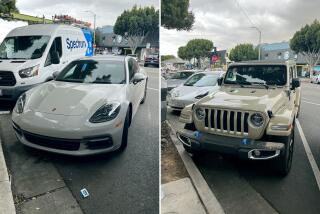Remade ’04 Grand Prix looks leaner, acts meaner
- Share via
A colleague spotted the Pontiac Grand Prix in the lot and noted: “It looks mean.”
Pontiac considers that a compliment.
The 2004 Pontiac Grand Prix that goes on sale this month, along with the ’04 Pontiac GTO and ’04 Chevrolet Malibu that go on sale this fall, are members of the mid-size sedan family at General Motors Corp. designated to lure buyers away from sport utility vehicles and back to cars.
More important, they are designated to lure consumers away from the Toyota Camry, Honda Accord and Nissan Altima, which owe their heritage to Japan even though they are assembled in the U.S.
The Grand Prix, like the GTO and eventually an SS version of the Malibu, is taking a daring approach by boosting performance over mileage.
For ’04 the Grand Prix has undergone a major remake. The most noticeable difference is that it is no longer wrapped in decorative body cladding. The same will be true of the Grand Am remade for ’05.
The reason? “For some pizazz,” said Bob Kraut, marketing director for the Grand Prix and the upcoming GTO and Bonneville.
Kraut said Pontiac wants to attract a more refined buyer to a more refined car.
“Studies show that 55% of cars are bought by people who make $75,000 or more a year, and we need to appeal to them,” Kraut said.
The Grand Prix is offered in GT1, GT2 and GTP versions, no more SE and no more coupe; just sedans.
The GT1 and 2 are powered by a 3.8-liter, 200-horsepower V-6 (the 3.1-liter, 175-horsepower V-6 is gone), while the GTP has a supercharged 3.8-liter V-6 that develops 260 horsepower if you use premium unleaded, 240 horsepower if you opt for regular.
I tested the Pontiac Grand Prix GT2 at length and the GTP just briefly -- it’s the only Prix to which you can add (for $1,395) the competition package: 17-inch performance radial tires speed-rated at 142 miles per hour; tap-shift automatic with a head-up display, or HUD, in the windshield to show the gears; a sports-tuned StabiliTrak stability system; stiffer shocks; higher-effort steering; and beefed-up stabilizer bars.
Whether GT or GTP, and whether GTP with or without the competition package, the focus is on power. But where the vehicles really strut their stuff is with their much improved handling, especially the GTP, which takes tight corners and sits flat without unnecessary lateral moves when maneuvering on twisting countryside roads.
It’s spirited but stable, especially the GTP with its precise steering response and more agile handling. Serious performance from a car that has a serious (yellow not offered) -- perhaps mean -- look to it.
“A front-wheel-drive car that handles like a rear-wheel-drive car” is how Kraut describes it.
All Prixes share the same exterior look, but suspension tuning, steering tweaks and tires give each a different personality. The base GT1, for example, comes with 16-inch touring tires and is tuned for softer ride; the GT2 comes with 16-inch radials, but is tuned for a firmer ride and a little more steering effort.
The GTP comes with 17-inch handling tires and higher-effort steering; the GTP with the competition package has 17-inch performance tires and the highest-effort steering. For optimum performance and handling, however, you pay in terms of stiff ride.
Whether GT2 or GTP, response is quick, but neither is the ultimate Prix nor the ultimate Pontiac in performance.
One reason for the emphasis on performance is “the Japanese imports on our landscape -- the [Nissan] Altima now has a 245-horsepower 6, the [Honda] Accord a 240-horsepower 6,” Kraut said.
Yet neither looks “mean.”
Besides performance, the ’04 Grand Prix offers such touches as rear doors that open nearly 90 degrees, fold-down rear seats to hold cargo and wide-mouth trunk openings.
“These are features we call tiebreakers when it comes to us versus the Japanese,” Kraut said.
Although performance runs counter to mileage, Grand Prix with the 200-horsepower V-6 is rated at 20 miles per gallon in the city and 30 mpg on the highway, but drops to 18/28 when supercharged.
The new Grand Prix is not without faults -- the worst one is the patch of rubber that’s supposed to keep the key fob from banging on the lower dash while driving. The patch needs to be softer and/or thicker because the rattling is unrelenting.
And any car designed for performance must have bigger exterior side mirrors to let you better see what is approaching. Of course, any high-performance car should offer an all-wheel-drive version, too.
“Not this year,” Kraut said.
Base price for the GT2 is $23,660 and the GTP $25,860. Standard equipment includes anti-lock brakes with traction control; power locks, mirrors and windows; tinted glass, rear-window defogger, air conditioning, CD player, power outlets, spoiler and remote keyless entry.
Among options, a power sunroof runs a hefty $795, and side-impact air bags cost $395. If you do lots of driving and radio listening, the XM Satellite Radio ($395 plus a monthly fee) provides commercial-free/static-free sound from 100 stations.




